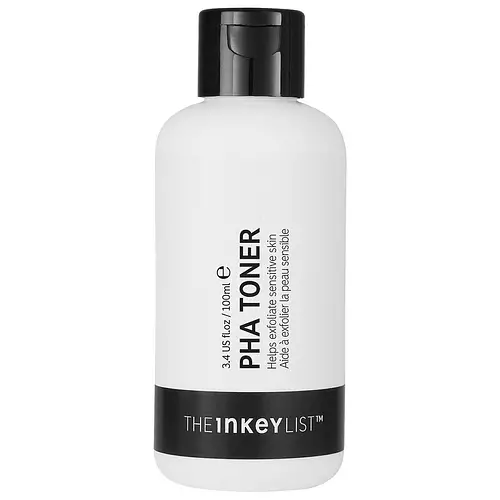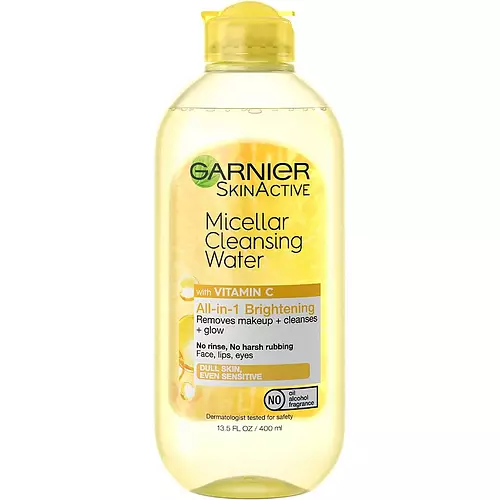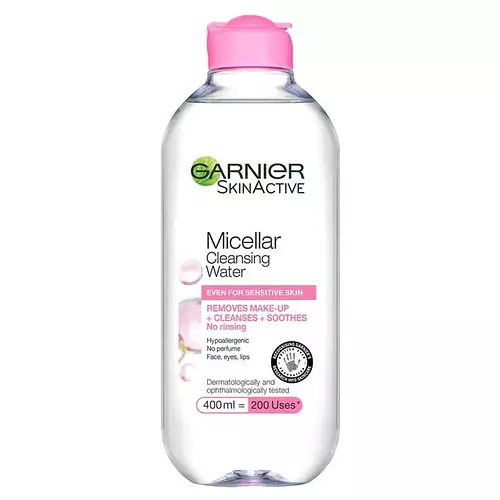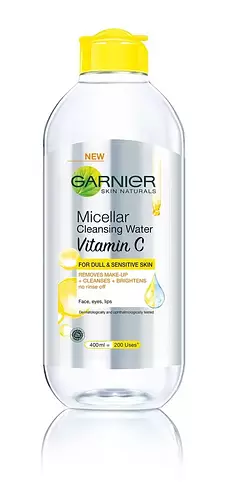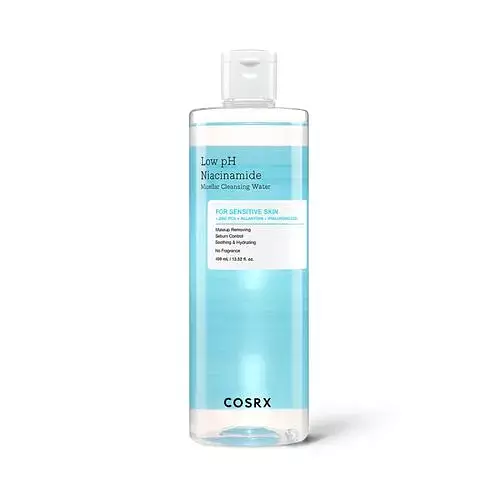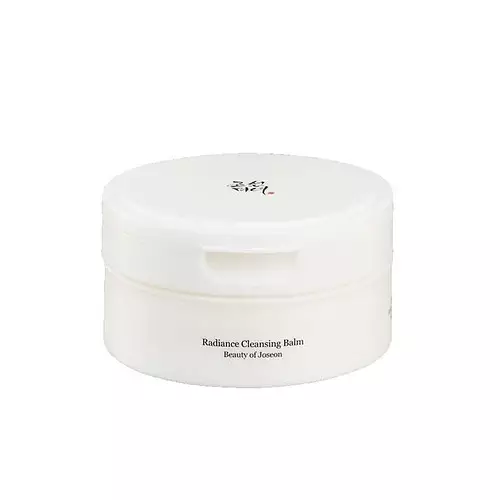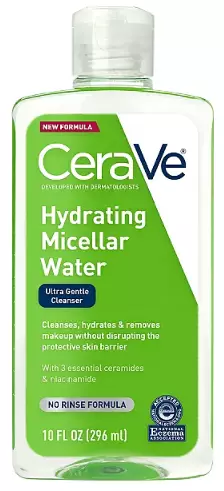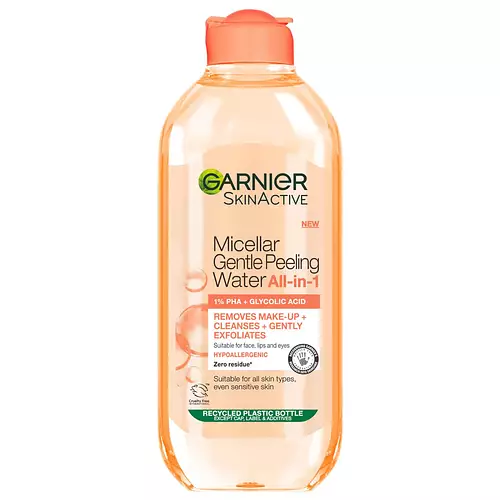
Garnier Micellar Gentle Peeling Water, 1% PHA & Glycolic Acid, Cleanse, Exfoliate & Glow Ingredients Explained
Published on May 22, 2023 Submitted by ele_
Overview
What it is
Makeup remover with 19 ingredients that contains AHA and PHA
Cool Features
It is cruelty-free and reef safe
Suited For
It has ingredients that are good for anti aging, dry skin, brightening skin, oily skin, reducing pores, scar healing, dark spots and better texture
Free From
It doesn't contain any harsh alcohols, common allergens, parabens, silicones or sulfates
Fun facts
Garnier is from France. This product is used in 3 routines created by our community.
We independently verify ingredients and our claims are backed by peer-reviewed research. Does this product need an update? Let us know.
Ingredient List (19)
You should know
Notable Ingredients
This product contains 1 ingredient that may have this attribute:
This product contains 1 ingredient that may have this attribute:
Benefits
This product contains 1 ingredient that may have this attribute:
This product contains 1 ingredient that may have this attribute:
This product contains 2 ingredients that may have this attribute:
This product contains 1 ingredient that may have this attribute:
This product contains 2 ingredients that may have this attribute:
This product contains 1 ingredient that may have this attribute:
This product contains 1 ingredient that may have this attribute:
This product contains 2 ingredients that may have this attribute:
Concerns
This product contains 1 ingredient that may have this attribute:
This product contains 1 ingredient that may have this attribute:
This product contains 1 ingredient that may have this attribute:
This product contains 3 ingredients that may have this attribute:
This product contains 1 ingredient that may have this attribute:
Ingredient Info
Alcohol Free
This product is free of harsh alcohols 🎉
Silicon Free
This product is free of silicons 🎉
Contains Fragrance
Ingredients in this product that are forms of fragrance:
Sulfate Free
This product is free of sulfates 🎉
Paraben Free
This product is free of parabens 🎉
Contains Oils
Ingredients in this product that are types of oil:
Not Malassezia Safe
Ingredients in this product that are not malassezia safe:
Reef Safe
This product is free of ingredients that damage reefs 🎉
EU Allergen Free
This product is free of EU allergens 🎉
Non Vegan
This product is not vegan 😥
Cruelty Free
This product is cruelty-free 🎉
Ingredients Overview
Ingredients Explained
Water. It's the most common cosmetic ingredient of all. You'll usually see it at the top of ingredient lists, meaning that it makes up the largest part of the product.
So why is it so popular? Water most often acts as a solvent - this means that it helps dissolve other ingredients into the formulation.
You'll also recognize water as that liquid we all need to stay alive. Talk about multi-purpose! If you see this, drink a glass of water. Stay hydrated!
Learn more about WaterHexylene Glycol is a surfactant. Glycols are a class of alcohols. Hexylene Glycol is a surfactant and emulsifier.
As a surfactant, Hexylene Glycol helps gather dirt and oil on your skin to be washed away.
As an emulsifier, Hexylene Glycol helps keep water and oil together. This prevents them from separating in a product. Hexylene Glycol also thins out the texture of a product by lessening viscosity.
Hexylene Glycol has a small molecular weight.
Learn more about Hexylene GlycolGluconolactone is a PHA. PHAs have a larger structure than AHAs and BHAs and are more gentle. It is an created by reacting gluconic acid with an alcohol.
When applied, Gluconolactone has the same affect on skin as AHAs such as lactic acid. It helps dissolve the dead skin cells in the top layer of your skin. This helps improve texture and brightens the skin.
Gluconolactone is a humectant and helps draw moisture to your skin. This helps keep your skin hydrated.
PHAs are more gentle than AHAs due to their larger structure. They do not penetrate as deeply as AHAs and take a longer time to dissolve dead cells. Studies show PHAs do not cause as much irritation.
PHAs also exhibit antioxidant activity by neutralizing free-radical molecules. This can help with anti-aging.
In a 2004 study, Gluconolactone was found to prevent UV damage in mouse skin cells. However, we still recommend wearing SPF especially after using exfoliating ingredients.
Learn more about GluconolactoneGlycerin is already naturally found in your skin. It helps moisturize and protect your skin.
A study from 2016 found glycerin to be more effective as a humectant than AHAs and hyaluronic acid.
As a humectant, it helps the skin stay hydrated by pulling moisture to your skin. The low molecular weight of glycerin allows it to pull moisture into the deeper layers of your skin.
Hydrated skin improves your skin barrier; Your skin barrier helps protect against irritants and bacteria.
Glycerin has also been found to have antimicrobial and antiviral properties. Due to these properties, glycerin is often used in wound and burn treatments.
In cosmetics, glycerin is usually derived from plants such as soybean or palm. However, it can also be sourced from animals, such as tallow or animal fat.
This ingredient is organic, colorless, odorless, and non-toxic.
Glycerin is the name for this ingredient in American English. British English uses Glycerol/Glycerine.
Learn more about GlycerinAnanas Sativus Fruit Extract comes from the pineapple fruit. Pineapples are native to South America. The components of pineapple give it mild exfoliating and skin nourishing properties.
Pineapples contain Vitamin C, Vitamin B6, copper, potassium, niacin, and other minerals. It also contains many phytochemicals, including ferulic acid, coumaric acid, arbutin, and more. These help condition the skin.
Bromelain can be found in all parts of a pineapple. It is a mixture of enzymes and is mildly exfoliating.
Learn more about Ananas Sativus Fruit ExtractPapain is an enzyme found naturally in the papaya plant's leaves, fruit, and roots. It has antimicrobial, soothing, and wound healing properties.
Glycine and Vitamin A are naturally found in papain.
While papain is often touted as skin-lightening, further studies are needed to prove this. However, papain has been shown to help soothe acne-inflammation.
Papain belongs to a class of enzymes called proteolytic enzymes. These enzymes break down peptides and amino acids.
Some studies found papain to be a potential skin sensitizer and allergen. Those with latex allergies might also be allergic to papaya.
Learn more about PapainGlycolic Acid is arguably the most famous AHA with research to back up its benefits. Its main role is to peel the top layer of skin cells from the newer layer of skin underneath. This helps skin to remove dark spots and look more even.
Glycolic Acid has shown to boost collage production, a protein that helps skin stay firm. Overall, Glycolic Acid helps with improving uneven tone, rough patches of skin, fine lines, wrinkles, and sun damage. It also increases skin hydration by playing a role in creating molecules that create hyaluronic acid naturally.
When applying Glycolic Acid, it is normal to feel slight stinging. The pH value and concentration of glycolic acid play a role in the effectiveness of the product.
Recent studies have shown Glycolic Acid may protect the skin against UV damage. However, you should always wear SPF, especially when using exfoliants.
Read more about some other popular AHA's here:
Learn more about Glycolic AcidWe don't have a description for Ppg-26-Buteth-26.
Peg-40 Hydrogenated Castor Oil is derived from castor oil and polyethylene glycol (PEG). It is used as a emollient and emulsifier.
As an emulsifier, it helps prevent ingredients from separating. It also helps make the other ingredients more soluble; it is often used to solubilize fragrances. This increases spreadability and elongates shelf life in a product.
Emollients help soothe and soften the skin. They do this by creating a protective film on your skin. This barrier helps trap moisture and keeps your skin hydrated. Emollients may be effective at treating dry or itchy skin.
This ingredient may or may not be vegan, depending on the source.
Peg-40 Hydrogenated Castor Oil may not be fungal-acne safe. We recommend speaking with a professional if you have any questions or concerns.
Learn more about Peg-40 Hydrogenated Castor OilChances are, you eat sodium chloride every day. Sodium Chloride is also known as table salt.
This ingredient has many purposes in skincare: thickener, emulsifier, and exfoliator.
You'll most likely find this ingredient in cleansers where it is used to create a gel-like texture. As an emulsifier, it also prevents ingredients from separating.
There is much debate on whether this ingredient is comedogenic. The short answer - comedogenic ratings don't tell the whole story. Learn more about comegodenic ratings here.
The concensus about this ingredient causing acne seems to be divided. Research is needed to understand if this ingredient does cause acne.
Scrubs may use salt as the primary exfoliating ingredient.
Learn more about Sodium ChlorideSodium Hydroxide is also known as lye or caustic soda. It is used to adjust the pH of products; many ingredients require a specific pH to be effective.
In small amounts, sodium hydroxide is considered safe to use. However, large amounts may cause chemical burns due to its high alkaline.
Your skin has a natural pH and acid mantle. This acid mantle helps prevent harmful bacteria from breaking through. The acid mantle also helps keep your skin hydrated.
"Alkaline" refers to a high pH level. A low pH level would be considered acidic.
Learn more about Sodium HydroxideCoco-Betaine is the natural version of Cocamidopropyl Betaine. It is often derived from coconuts.
Coco-Betaine is a surfactant, meaning it helps remove dirt and oil from the skin.
We don't have a description for Poloxamer 184.
Disodium EDTA plays a role in making products more stable by aiding other preservatives.
It is a chelating agent, meaning it neutralizes metal ions that may be found in a product.
Disodium EDTA is a salt of edetic acid and is found to be safe in cosmetic ingredients.
Learn more about Disodium EDTAPropanediol helps absorb ingredients into your skin, boosting their benefits. It can act as an emollient, making your skin softer. Propanediol can help products last longer by boosting the properties of preservatives within the formulation.
Propanediol is not likely to cause sensitivity and considered safe to use.
It is derived from corn or petroleum with a clear color and no scent.
Learn more about PropanediolPolysorbate 20 is made by combining ethoxylation of sorbitan, ethylene oxide, and lauric acid. It is a mild cleansing agent, surfactant, and emulsifier.
As a surfactant, it helps collect dirt and oils for washing. Emulsifiers prevent oils and water from separating.
Polysorbate 20 also adds scent to a product. Since it is made using sorbitol, it has a sweet scent. Sorbitol can also be found in fruits such as apples and peaches.
The lauric acid used to create Polysorbate 20 is often derived from coconuts.
Polysorbate 20 may not be fungal acne safe.
Learn more about Polysorbate 20Myrtrimonium Bromide is a preservative and a quaternary ammonium salt.
Quaternary ammonium salt is the salt of quaternary ammonium cations, or quats for short. Quats are used in products for their antimicrobial properties.
Myrtrimonium Bromide was determined to be safe in cosmetics and has low chance of irritation. It is not water soluble.
Learn more about Myrtrimonium BromideParfum is a catch-all term for an ingredient or more that is used to give aroma to products. Parfum, or fragrance, can be a blend of hundreds of chemicals or plant oils. This means every product with "fragrance" or "Parfum" in the ingredients list is a different mixture.
In the US, the alternative name for parfum is 'fragrance'. The term 'fragrance' is not regulated in many countries. In many cases, it is up to the brand to define this term.
For instance, many brands choose to label themselves as "fragrance-free" because they are not using synthetic fragrances. However, their products may still contain ingredients such as essential oils that are considered a fragrance. One example is Calendula flower extract. Essential oil ingredients still impart a scent or 'fragrance'.
Depending on the blend, it can cause allergies and sensitivities on the skin. Some ingredients that are known EU allergens include linalool and citronellol.
Products use parfum often to give products a scent or cover up smells of different ingredients.
The bottom line is: not all fragrances/parfum/ingredients are created equally. If you are worried about fragrances, we recommend taking a closer look at an ingredient. And of course, we always recommend speaking with a professional.
Learn more about ParfumBeautiful widgets for your website
Here's what our community thinks of the 19 ingredients in this product ✨
When to use
Here's some more info on how this product is used by our community.
Directions
Simply apply the product to a cotton or eco pad and wipe the face, eyes, and lips. No rinsing required.
Simply apply the product to a cotton or eco pad and wipe the face, eyes, and lips. No rinsing required.
When to use
We're dedicated to providing you with the most up-to-date and science-backed ingredient info out there.
The data we've presented on this page has been verified by a member of the SkinSort Team.
Read more about usCompared With
Here are some products that Garnier Micellar Gentle Peeling Water, 1% PHA & Glycolic Acid, Cleanse, Exfoliate & Glow is often compared with.
Want to compare it with a different product? Head on over to our comparisons tool and you can!

.webp)
